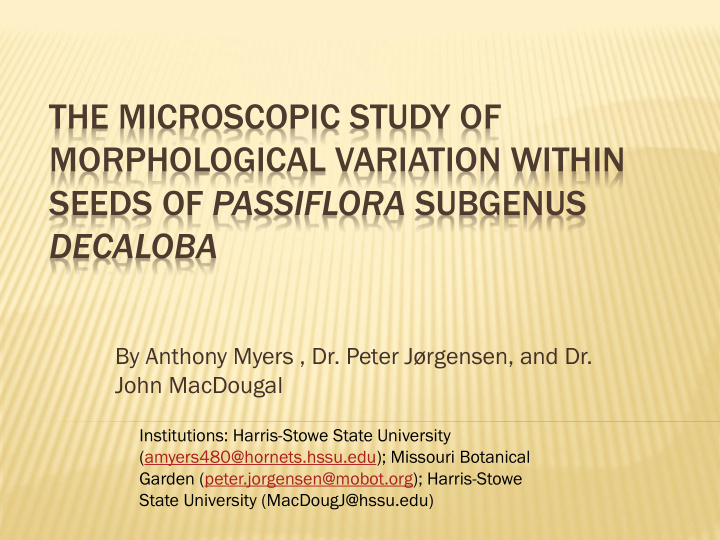



THE MICROSCOPIC STUDY OF MORPHOLOGICAL VARIATION WITHIN SEEDS OF PASSIFLORA SUBGENUS DECALOBA By Anthony Myers , Dr. Peter Jørgensen, and Dr. John MacDougal Institutions: Harris-Stowe State University (amyers480@hornets.hssu.edu); Missouri Botanical Garden (peter.jorgensen@mobot.org); Harris-Stowe State University (MacDougJ@hssu.edu)
ABSTRACT This study examined the morphology of the seed coats of Passiflora species representing the major lineages within the subgenus Decaloba using light and SEM microscopy. This was accomplished through preparing seeds by removing the sarcotesta from the sclerotesta and then to orient the seeds next to a ruler establish scale, micropylar end facing downward with the raphe pointing away from the ruler. The seeds were then photographed using a Nikon stereoscopic SMZ-10 microscope with Canon Power Shot A640 camera attachment. In addition, another sample of seeds were prepared in the same fashion — excluding the ruler — and attached to stubs with a colloidal graphite glue. These stubs were then photographed with a Nikon/JEOL Neoscope JCM-5000 SEM. The photographs were used to compose charts and keys to organize the seeds based on morphological data. This data showed that the seeds could be split into three groups. The first group consisted of the outgroup from the subgenus Deidamioides ; the second and third groups come from the subgenus Decaloba , with the second group consisting of punctate-reticulate seeds and representing several different infrageneric supersections; and the third group, consisting of ribbed seed species, all from the supersection Decaloba . The seeds of the second group are larger and longer than seeds from the other group and found in more basal lineages in subgenus Decaloba . The seeds of the third group varied in size and rib texture with some seeds possessing smooth or textured, rugose ribs and certain species had seeds very small (barely 3mm). No other definite patterns could be found within the third group, but based on seed morphology alone, a secondary outgroup to subgenus Decaloba might consist of P. obovata due to its unique rib texture but this would have to be followed up with further study.
INTRODUCTION The genus Passiflora (Passifloraceae), has over 550 species and is divided into five subgenera The subgenus Decaloba , the small-flowered passion flowers, comprises more than 235 species This study examined the morphology of the seed coats of Passiflora species representing the major lineages within the subgenus Decaloba using light and SEM microscopy
HISTORY OF THE PASSION FLOWER When Spanish explorers were introduced to passion fruit they called them “granadillas” after the pomegranate Spanish missionaries fascinated by the flowers suggested that the flower structures represented the P. vespertilio flower Passion of Christ The widespread religious symbolism lead Carolus Linnaeus to use Passiflora as the genus name (Vanderplank 2000; Estrada & Rodri ́ guez 2009) P. vespertilio fruit
METHODS Fifteen species were taken from dried herbarium specimens in MO All species are from subgenus Decaloba and represent major lineages within the subgenus (supersections and sections, Feuillet & MacDougal 2003)
METHODS (CONT.) Seeds prepared for microscopy by removing the sarcotesta, and aril if needed, from sclerotesta Sample size of one to three seeds chosen for light microscopy Seeds laid micropylar end down, raphal side away from the ruler Photos taken with a Nikon stereoscopic SMZ-10 microscope with Canon Power Shot A640 camera attachment
METHODS (CONT.) Sample size of one to two seeds selected for SEM examination Seeds prepped by letting them completely dry out, gluing them to a stub, and sputter coating them with gold A Nikon/JEOL Neoscope JCM-5000 SEM was used for photography A scoring chart and key were made from the morphological data
RESULTS The seeds could be placed into 3 groups The first group is an outgroup; sole species P. arbelaezii P. arbelaezii The second group consists of punctate-reticulate seeds from multiple infrageneric supersections P. cissampeloides P. pterocarpa
RESULTS (CONT.) The third group consists of ribbed seeds, all from supersection Decaloba P. punctata P. rovirosae Two species, P. punctata and P. rovirosae have smooth seeds The other seven species have P. pavonis textured, rugose seeds P. vespertilio P. bilobata
RESULTS (CONT.) P. obovata is an exception as its ribbed characters don’t fit into any of the three groups Recent studies (Krosnick et al. 2012) suggest its placement within the supersection Hahniopathanthus , included in group two above, but it is rather different Phylogenetic tree of subgenus Decaloba with seed species included (Krosnick et al. 2012)
CONCLUSIONS Seeds fall into three groups First group is P. arbelaezii , a seed with both punctate- reticulate and ribbed characters The second group consists of punctate-reticulate seeds that are larger than the other groups The third group consists of ribbed seeds; rib characters either smooth or textured, rugose ribs P. obovata may be a potential secondary outgroup but further study is needed
ACKNOWLEDGEMENTS Assistance and support from Tommie Turner, John MacDougal, Peter Jørgensen, David Bogler, Sandra Arango, Robert Ealy Jr., Jayashree Balakrishna, Wendell W. Brooks, Rachel Hillabrand, Sharon Carter, Missouri Botanical Garden Peter Raven Library staff, and The National Science Foundation is gratefully acknowledged.
REFERENCES Corner, E.J.H. 1976. The Seeds of Dicotyledons vols. 1 and 2. New York: University Press. Estrada, A. and Rodri ́ guez, A. 2009. Flores De Pasio ́ n De Costa Rica = Passion Flowers of Costa Rica . Costa Rica: Editorial INBio. Feuillet, C., and J. M. MacDougal. 2003 [2004]. A new infrageneric classification of Passiflora L. (Passifloraceae). Passiflora 13: 34-38 Krosnik, S.E., Porter-Utley, K.E., MacDougal, J.M., Jørgensen, P.M., and McDade, L.A. Manuscript submitted 2012. New Insights into the Evolution of Passiflora subgenus Decaloba (Passifloraceae): Phylogenetic Relationships and Morphological Synapomorphies. Systematic Botany . Pe ́ rez- Corte ́ z, S. 2007. Atlas Morfolo ́ gico De Semillas En Especies Del Ge ́ nero Passiflora L. Presentes En Venuzuel. Caracas: Fundacio ́ n Instituto Bo ́ tanico De Venezuela. Ulmer, T. and MacDougal, J.M. 2004. Passiflora: Passionflowers of the World. Portland: Timber Press. Vanderplank, J. 1991. Passion Flowers and Passion Fruit. Cambridge: MIT Press. Vanderplank, J. 2000. Passion Flowers. Cambridge: MIT Press.
Recommend
More recommend